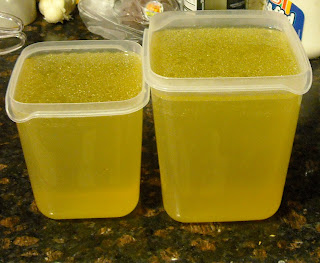Let's start at the very beginning, a very good place to start (tee hee.)
In class we spent our first day learning the basics of the kitchen: safe chicken = 160 degrees, when walking with a knife, hold it against your leg with the tip pointing down and the blade pointing behind you, don't use metal utensils in reactive pots and pans, etc, etc, etc. Very valuable and useful information that we blasted through in four short hours.
Our second day in class we talked about stocks, broths and roux based sauces.
Stock is a liquid made from bones, veggies and seasonings where all the solids and fats are removed.
Broth is a liquid made from meat and bones, veggies and seasonings where the solids are removed but some of the fat is left in.
A roux is a thick sludgy looking goo made from mixing flour with clarified butter and stock. This is the base for bechemel sauce, gravy, veloute, gumbo and other preparations. Since flour has declared war on my intestines, I will not be giving it the satisfaction of being prominently featured in my blog. So there, flour!
I decided to jump right in and make myself some chicken broth. I chose a broth because chicken bones/parts are not all that easy to come by unless you've been planning ahead and saving bits and bobs from your chicken carcasses. Since I didn't even have the know-how to cut up a chicken or which bits went into the stock and which were used in the original preparation, I found it a lot easier to just dump in a whole roasting chicken. The ingredients for a broth are simple.
There is no real recipe, it's more like a formula and there is also no way to KNOW for sure that you're doing it right. The most frustrating and difficult thing I've had to understand in school so far is that when it comes to stock/broth/demi-glace, you won't really know if your batch is good until you use it in a recipe. Until you are experienced and familiar with the delicate nuances of these things, you won't be able to smell, taste or see the quality of your finished product. This KILLS me. It's a scary feeling freezing your broth and not knowing if it is going to taste like anything or not when you put it in that risotto you'll make down the line. As much as I hate this, it's part of being a chef and I am learning (slowly) to trust myself and be patient. I can't tell you the satisfaction I got from tasting that first risotto made with my own, from scratch, chicken broth. It was perfection.
I say all this mostly to caution you. When you make your own broth and you go in for that taste before you take it off the stove, it ain't gonna taste like much of anything. My first thought when I tasted mine was "chicken water." You don't add salt and pepper to broth; you add them when you are seasoning the dish you make WITH the broth or stock. Since there is no salt or pepper, the flavors in the liquid are delicate. You should taste the essence of the type of meat or bones you used and a mere hint of the vegetables and herbs.
So now, without further ado: How to make Chicken Broth
Makes 2 Quarts
- 4 lb chicken (I used a roaster)
- 1/2 - 1 lb medium chopped mirepoix (40% Onion, 40% Celery, 20% Carrot) I used: 3/4 of a large onion, 2 small/medium carrots (peeled) and 1 large celery stalk
- 1 boquet garni (thyme, chives, parsley, peppercorns, white leek leaf, bay leaf) -you just eyeball the ammounts here, check my picture
In a large stock pot place chicken, breast facing up
Cover with cool water so that the chicken in submerged and there are at least 2 inches of water above the top of the chicken
Add the mirepoix
Simmer slowly over medium heat. If bubbles form, reduce the heat slightly. You want the broth to "tremble" but never boil. Do not put a lid on the pot.
Continue simmering for about 2 1/2 hours, skimming and discarding fat occasionally. Add the bouquet garni and simmer an additional 30-40 minutes. Since we are straining out everything, we can add the bouquet garni loose. If we were making soup, we might tie it together with kitchen twine so it could be easily removed.
Let cool. Remove chicken*.
Strain the liquid through moistened cheese cloth over a colander.
Pour resulting liquid broth into smaller containers to allow it to cool enough to be placed in the refrigerator.
Cool in the fridge overnight.
The next day, skim the fat off the broth with a spoon or strainer and place the broth in freezer bags in 2-4 cup increments. Freeze flat on a cookie sheet for easy storage.
Thaw and use as needed.
*I used the chicken for chicken salad and made the BEST most MOIST and TASTY chicken salad I have ever made!
Thursday, December 3, 2009
Subscribe to:
Post Comments (Atom)










No comments:
Post a Comment